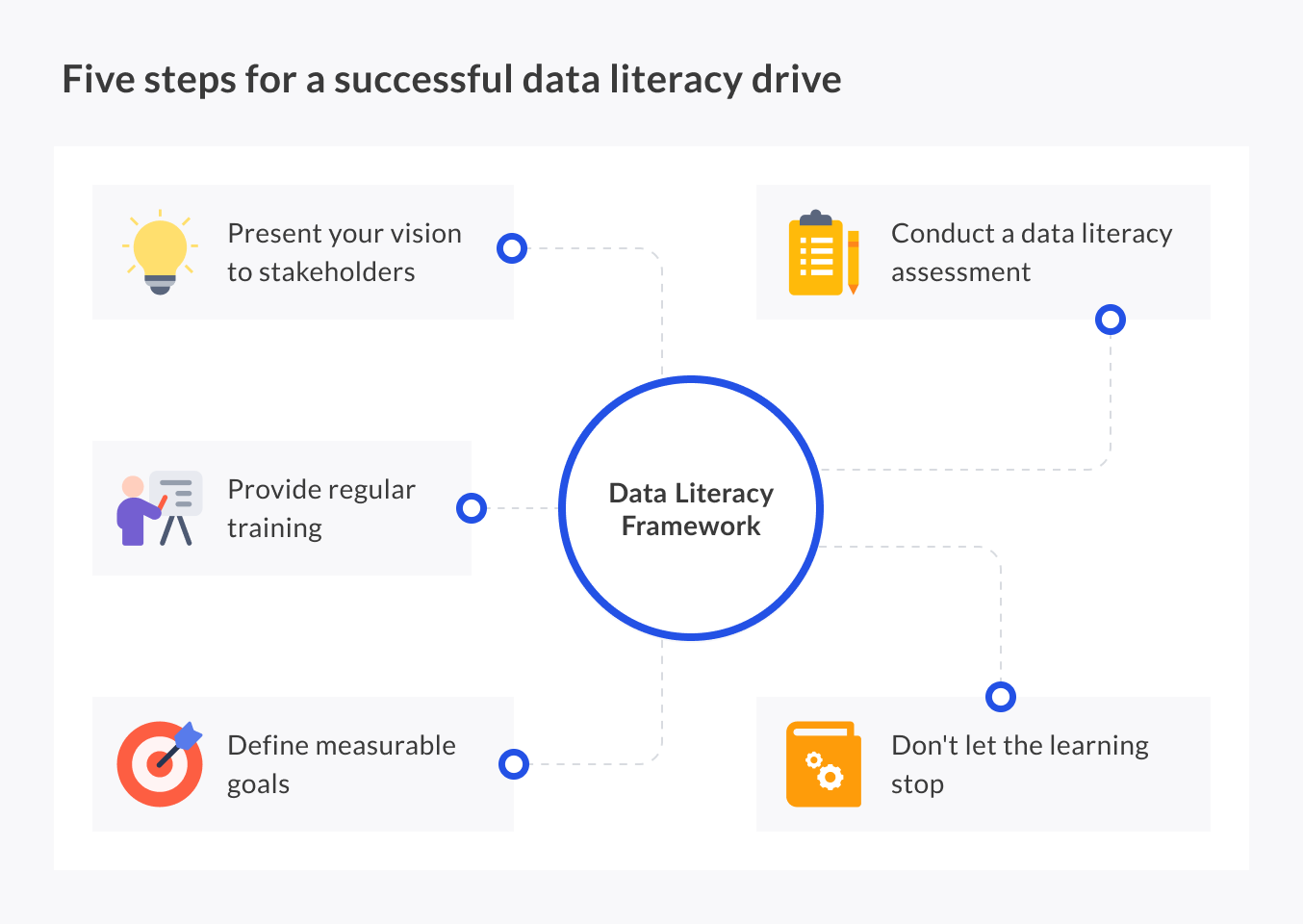Forbes estimates that there are currently 200 billion IoT smart devices that collect data for organizations around the world. These devices produce huge data reserves that workers need to understand, engage with, and translate to value. Otherwise, aggressive data collection is rendered pointless. In this article, we assess how you can upskill data literacy across your enterprise so that stakeholders can proficiently work with data for the betterment of your organization.
Data literacy, ‘the ability to derive meaningful information from data’, is a crucial requirement for stakeholders in the digital age. It goes hand in hand with digital transformation and equips workers with the necessary skills to reason, analyze, and use data. At Maximl, we see data literacy as the bridge through which organizations cross from merely amassing data to mining data for actionable information.
“In a recent survey of more than 7,300 business decision-makers, just 24% consider themselves data literate.”
Previously, ‘hard’ skills like data analysis/ extraction, programming language, parallel processing, SQL, and information normalization were essential for a worker to be considered data literate. But nowadays, digital platforms have done the ‘heavy lifting’ for organizations by absorbing these skills as add-ons into their solutions. Data scientists and analysts may still need to learn hard skills but for general stakeholders, training should be focused on getting them acquainted with soft skills like:
- How to derive maximum value from the platform solution
- How to assess the veracity of the AI output (and not merely take it at face value)
- How to accurately interpret data in line with business context through critical thinking and balanced judgment
- Data safety, management, and accountability for cyber-security reasons
A data literacy framework will provide a long-term structure for data education and ensure that data-literate workers become the norm from top to bottom in your organization.
Five steps for a successful data literacy drive
- Present your data literacy ‘vision’ to stakeholders
- Conduct a data literacy assessment
- Provide regular training
- Have measurable goals
- Don’t stop

Present your data literacy ‘vision’ to stakeholders
Enterprise-wide data literacy, like digital transformation, will not work if stakeholders are unaware of the importance of data literacy and the value it can add to their work. Management should present in clear terms the rationale behind the data literacy drive and the effect worker fluency will have on the business goals. Ideally, this presentation should be made by a ‘digital head’, perhaps a chief data officer, whose portfolio will reassure the workers that the organization is serious about data literacy.
The Chief data officer will take leadership and stir up commitment in the workers. He/She/They will outline how data literacy will help workers make better decisions and improve the overall efficiency of their work. Don’t have a digital team yet? Read our blog post about setting up a digital cell in manufacturing.
Conduct a data literacy assessment
According to the global research and advisory firm Gartner, there are 5 ‘levels’ of data fluency:
- Conversational: Understands basic data concepts and their application
- Literacy: Can speak, write, and engage with data for application in problem-solving or decision making
- Competency: Can design, develop, and apply data from concept through outcome
- Fluency: Data literate across most business domains in a particular industry.
- Multilingual: Data literate across multiple business domains in multiple industries.
After rousing the interest of workers in the data literacy program, the next step is to gauge their level of understanding. This can be done by a data literacy assessment test. The results of the test will enable the organization to tailor training consistent with the current needs of individual workers.
Provide regular training
Quality data training and education is the only route to data literacy. To account for the disparate data fluency and stakeholder requirements, workers should be divided into learning groups consistent with their competency test results. This, as opposed to shoe-horning everyone into the same training box, will ensure that workers, besides learning specific areas relevant to their work, can be taught at their level of understanding.
Study groups should be manageable so that in-depth discussions can be held and assigned tutors will have leeway to track individual progress. Also, data should be provided and made readily available for workers to immediately practice what they’ve learned. This can be through data literacy projects (individual or grouped) or real-life applications that are embedded in stakeholder roles. And in cases where workers perform poorly in practice assessments, follow-up training can be conducted and specialized mentor groups assigned to these workers.
How to conduct data training
Many organizations use MOOCs (massive open online courses) to implement their training programs. The challenge with MOOCs is that while they are effective at specialized training, they may not fulfill the peculiar needs of your organization or provide complete solutions for your workforce.
An alternative is to set up an in-house data literacy academy or partner with an external academy. The result will be an end-to-end approach that delivers maximum impact with creative and sustained tutorship.
Furthermore, you may provide books/ blog resources for your workers – in addition to a dedicated page in a Connected Worker platform from where they can share insights and communicate in real-time with their tutors.
Have measurable goals
For a successful data literacy journey, you need to have an understanding of the signposts of success. An underlying set of ideas about what the organization intends to achieve at every stage (divided into time frames) of the program should be documented for regular reference.
Moreover, key questions like what business processes will be affected, which department needs urgent up-skilling, and what skills need to be taught should be ascertained at the initial stage of the program.
Shown in the image below are some data literacy goals and how they can be measured:

Don’t stop
Data literacy is an educational endeavor, and education never ends. The first challenge is to shift the mental attitude of stakeholders and to get them interested in learning about data. Even when this shift occurs, getting everyone to fluently speak the data language will still take time. Internal and external challenges may arise that will attempt to sabotage the program, but don’t be fazed.
Ultimately, your reward will be an in-house data excellence drive that empowers accurate decision-making, enhances productivity, and maximizes revenue.
Maximl’s digital platform simplifies data literacy for stakeholders by allowing them to focus on learning soft skills that are relevant to their work. Our Connected Worker solution unifies workers and tutors in a digital hub for knowledge-sharing and enriched collaboration.




